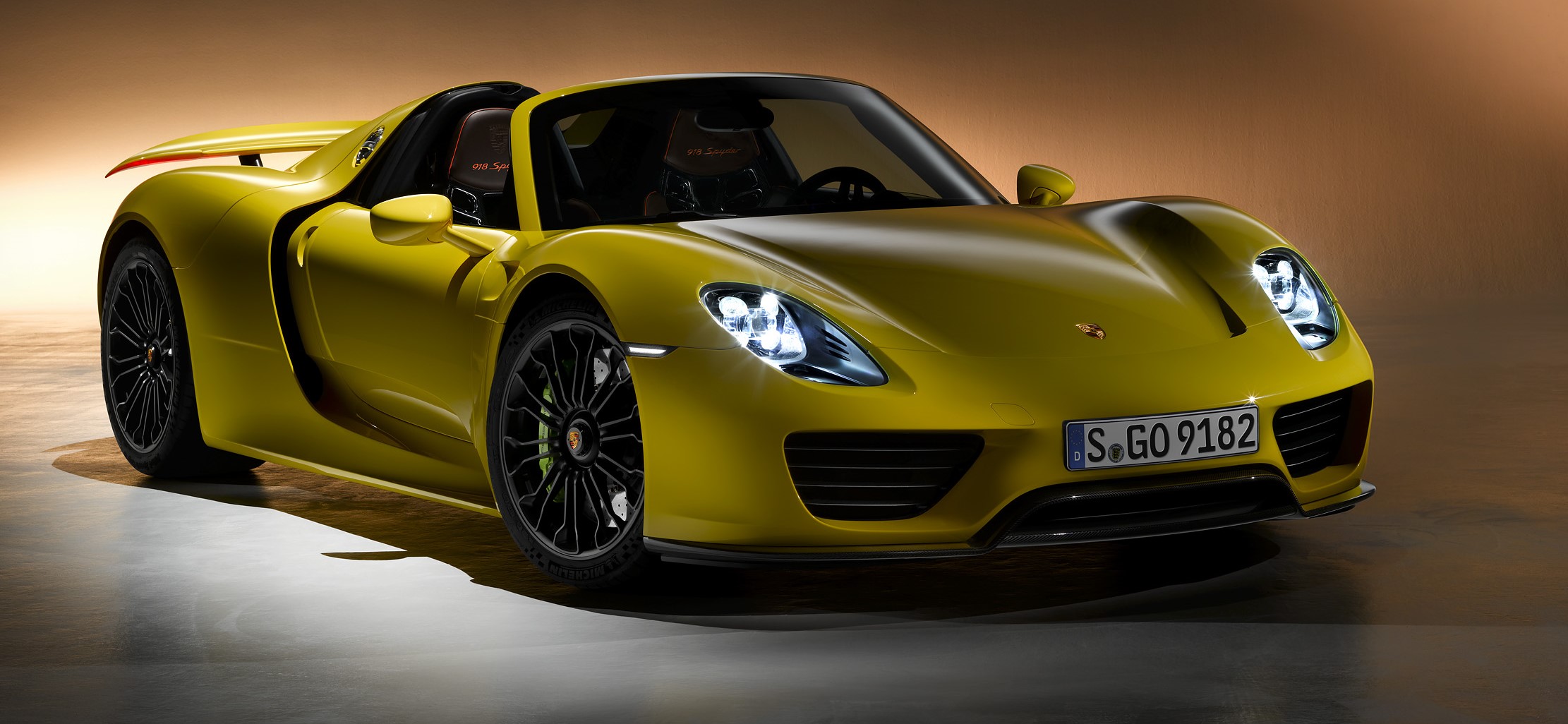
Porsche produced 918 units of the 918 Spyder, a limited-production hybrid supercar, between 2013 and 2015. Production began on September 18, 2013 and ended in June 2015. The cars were hand-built by a small team in a specially constructed facility, with each car taking around 100 hours to assemble. The 918 Spyder was originally a concept car at the 2010 Geneva auto show. It has a 4.6-liter V8 engine and two electric motors, producing a total of 887 horsepower and 944 lb-ft of torque. The cars were priced starting at $845,000 in the United States and sold out quickly, with around 300 ending up in the country. Other countries with significant orders included China and Germany, with around 100 each, and Canada with 35.
Specifications: Porsche 918 Spyder (pdf)
In the 918 Spyder, Porsche is launching the future of the sportscar: As the first vehicle to boast global road homologation, the model beat the record of seven minutes set for a lap of the Nürburgring Nordschleife, achieving a time of 6:57 minutes. What’s more, the 918 Spyder can glide through the city without releasing any emissions, and virtually without a sound.
The maximum level of performance delivered by the vehicle, namely through its system output of 887 hp and minimal consumption figure of three litres per 100 kilometres (NEDC), is the result of a unique plug-in hybrid concept. To meet the driver’s requirements, the 918 Spyder exhausts all possibilities offered by the combined drive of combustion engine and electric motor.
Hybrid drive enhances dynamic performance
Porsche hybrid drive technology offers efficiency and uncompromising dynamic performance in equal measure. Porsche had already taken on this pioneering role in the development of plug-in hybrids with the Panamera S E-Hybrid. Now Porsche is expanding this role in the super sportscar segment thanks to the 918 Spyder. The key to this is the targeted use of the combustion engine and two electric motors while exploiting the specific benefits offered by each power unit.
Drivers can choose from five driving modes that allow optimum control of the single or mixed drive through the 4.6-litre, eight-cylinder engine delivering 608 hp (447 kW) and the two electric motors with a combined 286 hp (210 kW). The vehicle’s range extends from pure electric driving over a distance of 30 kilometres and more, through to the uncompromising configuration for the race track. The 918 Spyder fulfils its claim of being capable of setting records for top racing drivers, while at the same time being an uncomplicated sportscar for day-to-day use.
The dynamic performance of the 918 is possible courtesy of the unique all-wheel drive concept with a combined combustion engine and electric motor drive system on the rear axle and a second electric motor on the front axle. This concept is based on Porsche’s motorsport development work for the successful 911 GT3 R hybrid. The additional, individually controllable front-wheel drive enables new driving strategies to be used for extremely high yet safe speeds through bends in particular. What’s more, the advanced Boost strategy provides an intelligent means of managing the energy of the electric drive. The strategy ensures that all it takes for the unrestricted total power of the 918 Spyder to be harnessed is by fully depressing the accelerator pedal, to have maximum acceleration at every burst of speed.
Porsche’s future generations of sportscar will benefit from the pioneering achievements in this technology benchmark. The 918 Spyder embodies the traditional Porsche virtue, while providing impressive evidence of the potential provided by plug-in technology for maximum coverage between performance and efficiency. In short, the 918 Spyder contains the genetic blueprint for the Porsche sportscar of the future.
A new super sportscar for a new decade
The 918 Spyder has been developed fully consistently and from the ground up as a performance hybrid with plug-in technology. In summer 2010, the Advisory Board of Dr. Ing. h.c. F. Porsche AG gave the green light for the sportscar’s series development. The concept study of the hybrid super sportscar – which combines the performance of a high-performance sportscar of over 600 hp with the low-emission three-litre consumption of a compact car – made its début at the Geneva Motor Show in 2010.
After just three years in development, the 918 Spyder is now continuing the series of super sportscars in Porsche’s history. Following the ultimate sportscars of their decade – the 550 Spyder, the Carrera GTS, the first Porsche 911 Turbo, the 959, the 911 GT1 and the Carrera GT – the 918 Spyder is providing new and key momentum for developing future vehicle concepts.
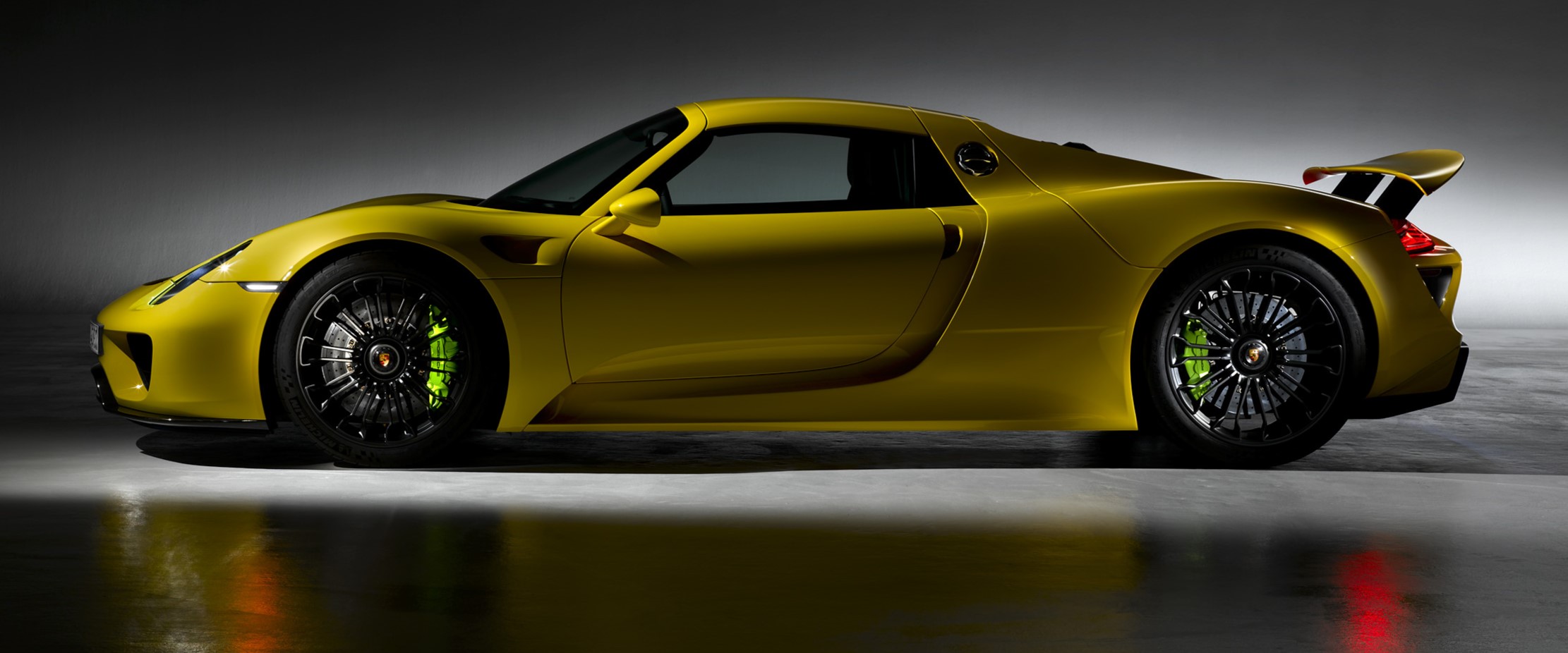
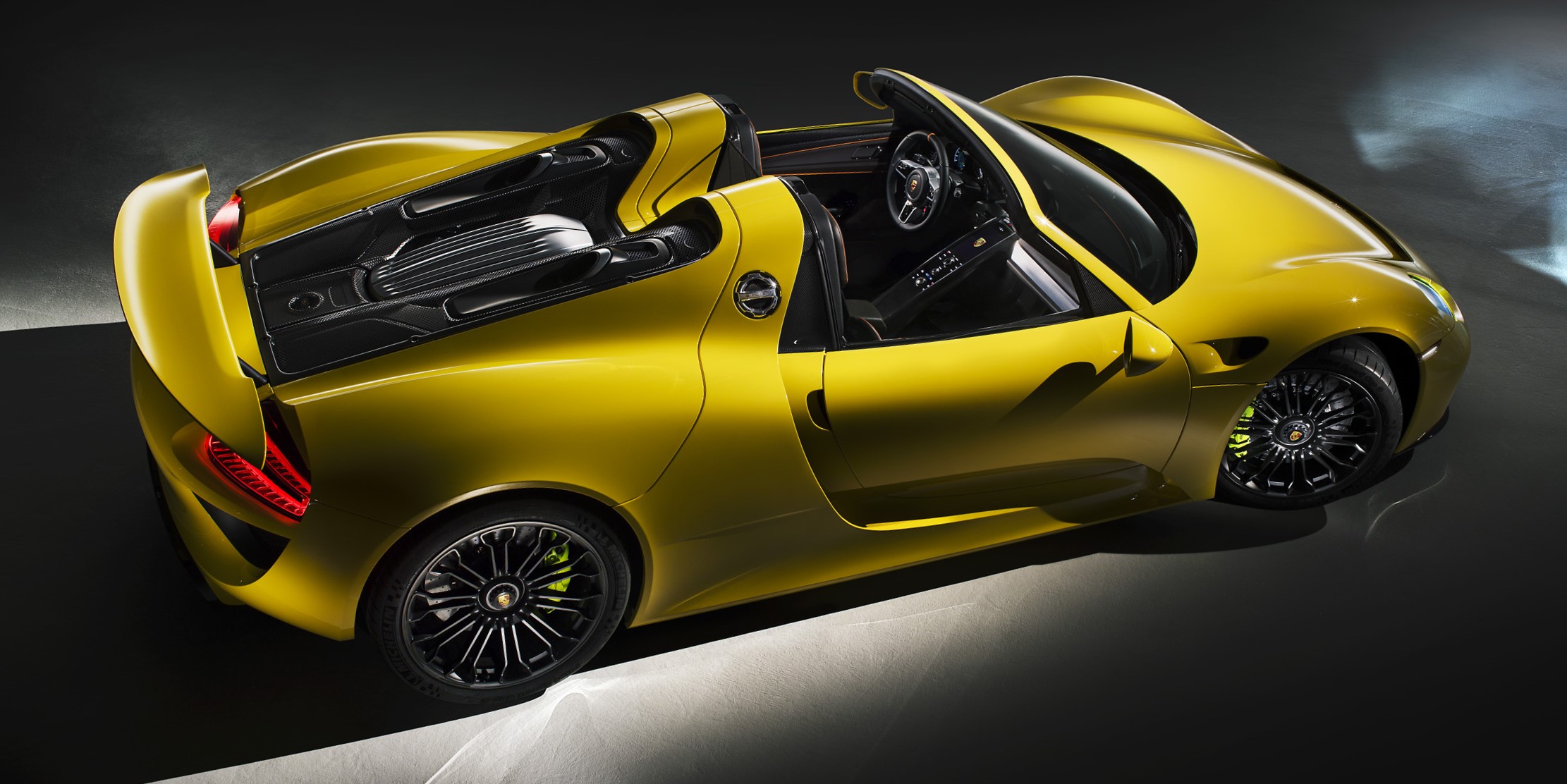

Interior and features
Ground-breaking control concept: Innovative black-panel technology in the cockpit
The driver is at the heart of all the technology in the Porsche super sportscar. With this in mind, the engineers have developed a cockpit that is typical of the brand and pioneering in its clarity. The cockpit concept is divided into two basic sections: The first section comprises the controls that are important for driving. These items are grouped around the multi-function steering wheel and combined with driver information displayed on three large round instruments.
The second section comprises the infotainment block housed in the elevated centre console, which was originally introduced in the Carrera GT. Systems like climate control, wing adjustment, lighting and the Porsche Communication Management (PCM) system, along with the Burmester High-End sound system featuring eleven loudspeakers, can be operated intuitively via the multi-touch control functions on the innovative black panel display.
The carbon of the monocoque is visible in the entire interior, conveying the motorsport feeling characterised by the 918 Spyder. All parts in the interior are manufactured from precious materials, and have both a visual and supporting function in the vehicle. For instance, elements made from brushed aluminium also act as supporting components in the interior. The displays are also trendsetting, scratch-resistant and non-glare. In addition, the pane on the information display, for example, is provided with six protective layers.
New lightweight bucket seats made from carbon
The driver and front passenger sit in completely redesigned carbon fibre-reinforced plastic bucket seats that boast a lightweight design. These seats provide a glimpse into the future of bucket seats from Porsche. The main focus during the development phase was on a lightweight design and a very low and sporty seating position. To keep the gross weight to a minimum, headrests and airbags were integrated into the seat. The height of the bucket seats can be adjusted electrically; however, the seats are not folding.
In typical Porsche fashion, the 918 Spyder is started to the left of the steering wheel. To the right of the steering column is the selector lever for the D, N and R positions of the PDK. Immediately next to the lever is the button for activating the electric parking brake. Three round instruments provide the driver with all the vital information needed for driving. A special feature in this respect is the powermeter ring all around the central rev counter: The upper semi-circle made up of white LEDs indicates the top power of the combustion engine. The lower semi-circle is made up of green LEDs, indicates the electric power output and lights up during recuperation.
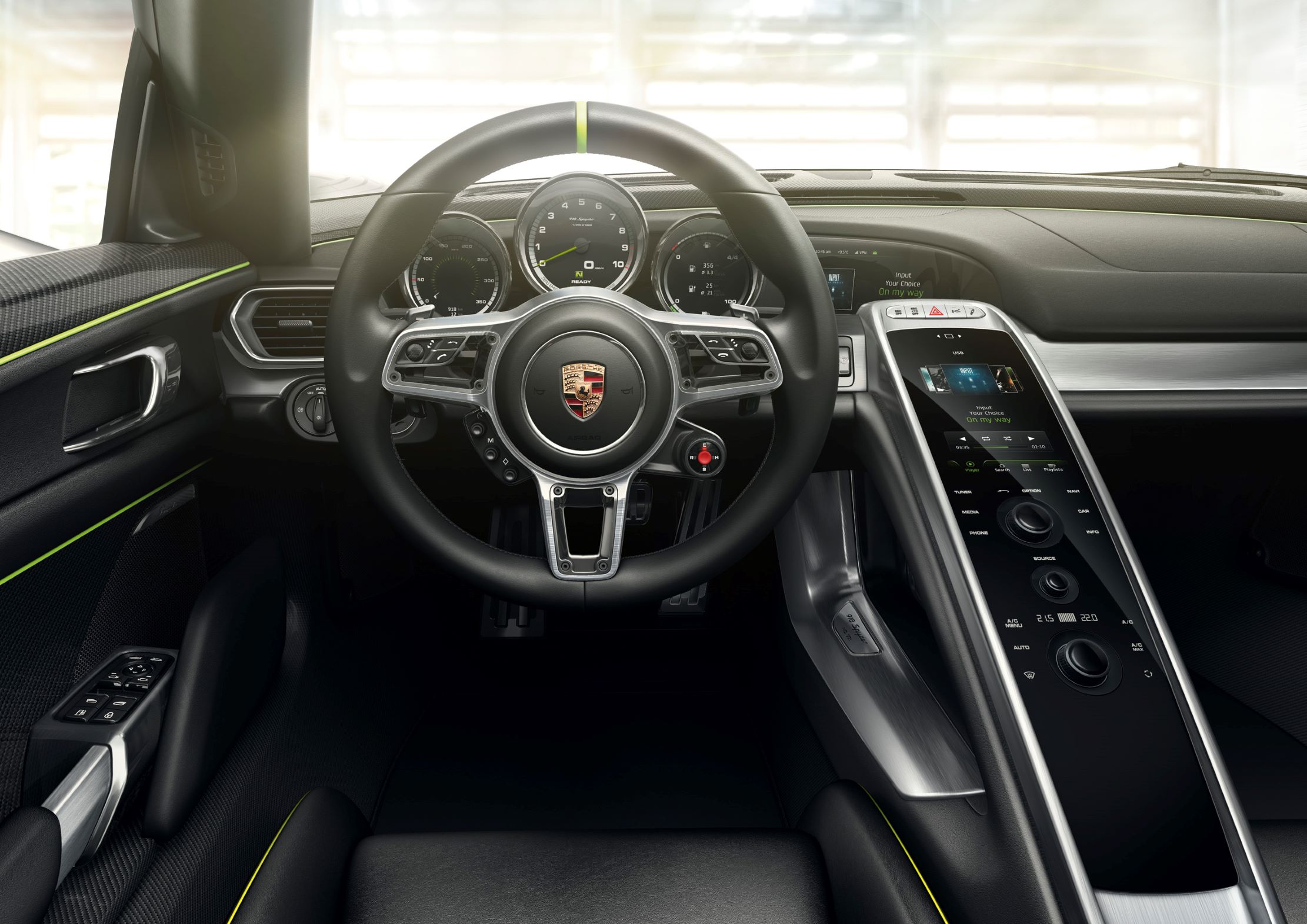
Three-spoke steering wheel boasting new functions
The three-spoke steering wheel is also a completely new development and paves the way for the coming generation of Porsche steering wheels. All vehicle functions that pertain to driving are integrated into the steering wheel. The central function is performed by the innovative map switch, which can be rotated to set the four basic driving modes. The Hot Lap configuration is activated in Race Hybrid mode by pressing the red button. The steering wheel incorporates other features, including shift paddles, a four-button module for cruise control and PDK functions. In short, the driver never need take his hands off the steering wheel.
Thanks to the clear structure and logical arrangement of the new infotainment system in the horizontal centre console, it is intuitive for the driver to use the Porsche Communication Management (PCM) system. Ergonomics and readability have been optimised by separating operation between the seven-inch touchscreen in the console and the display in the eight-inch screen in the instrument panel. Using additional control panels beneath the touchscreen enables the driver to navigate quickly through functions and operate comfort, air conditioning, vehicle settings and PCM functions directly from these panels.
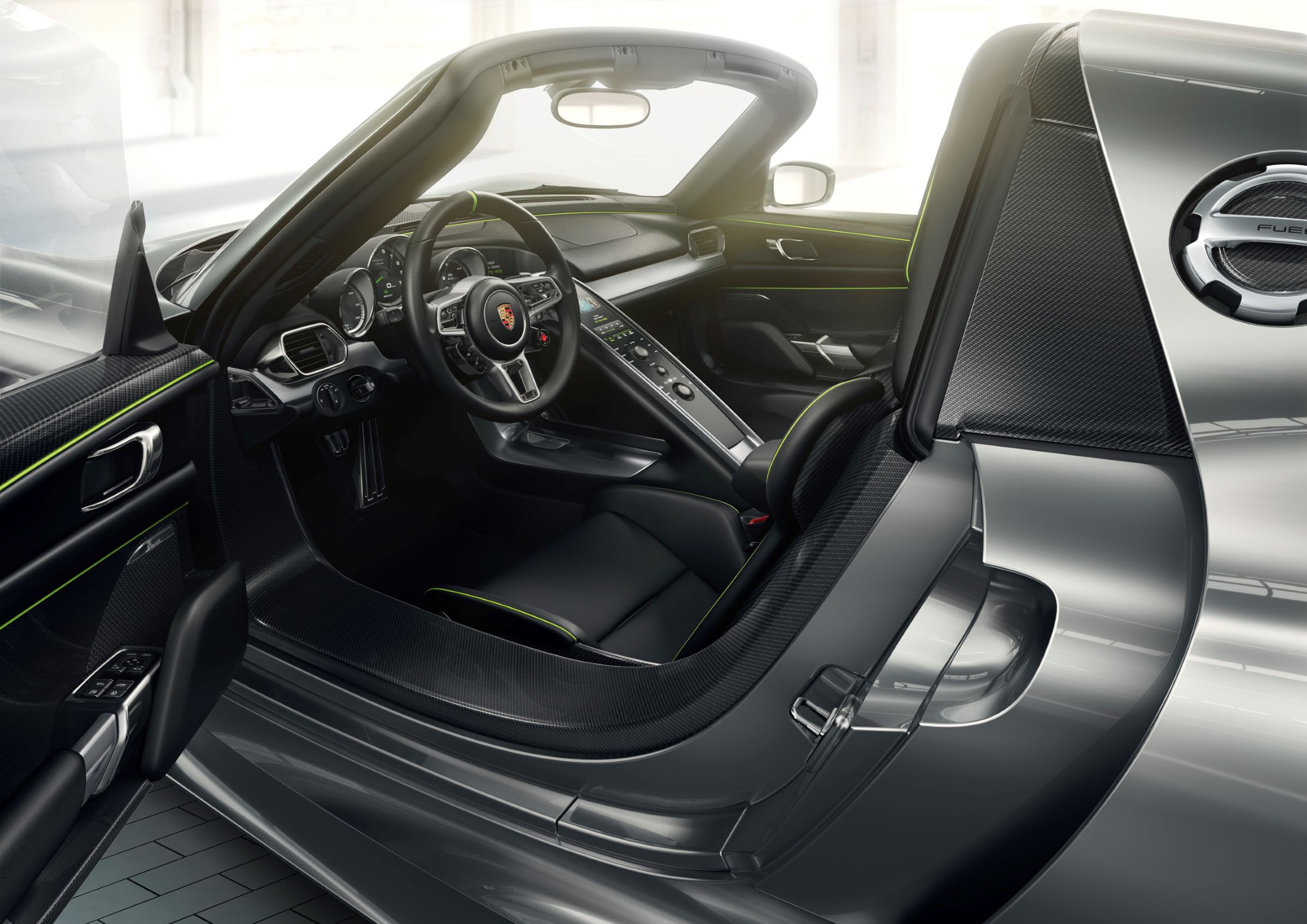
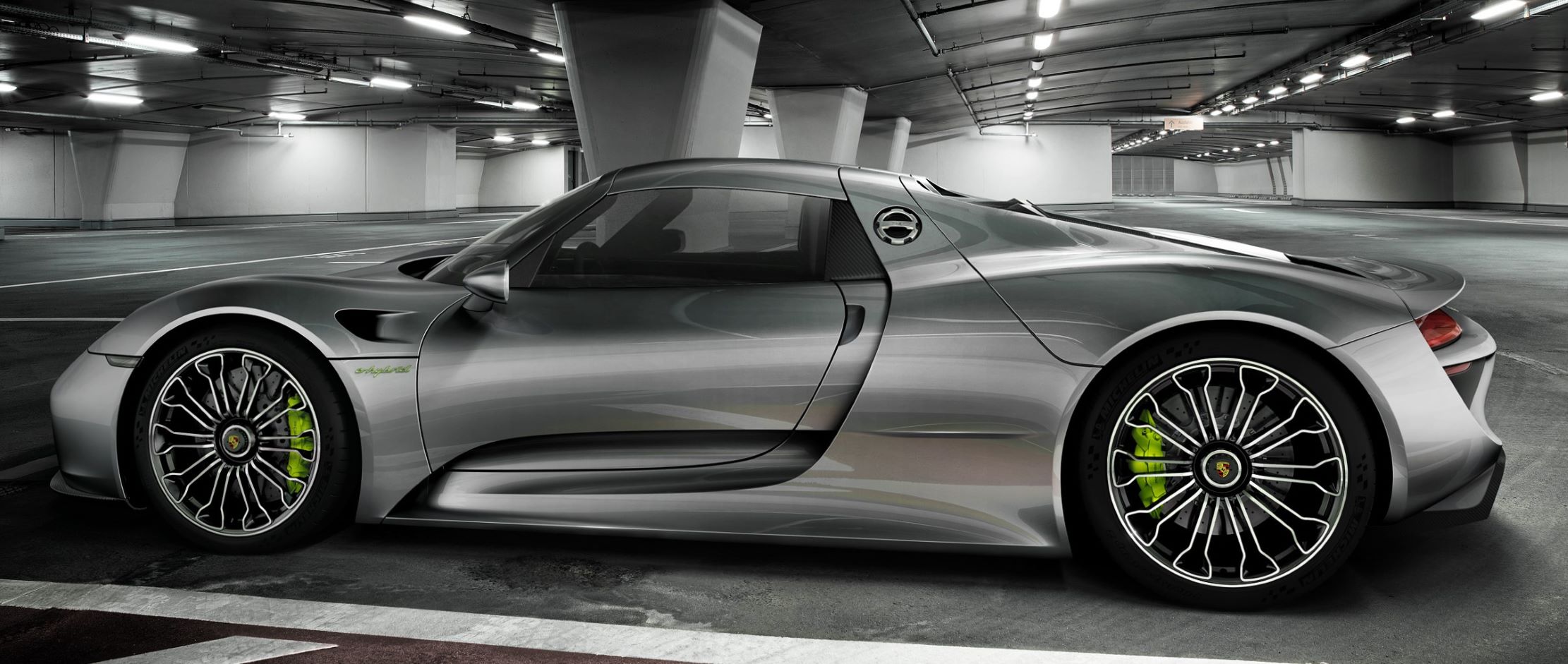
Design and body
Perfect synthesis of form and function
The design of the 918 Spyder pays homage to legendary Porsche race cars. It is based firstly on the 917, which won overall victories for Porsche at Le Mans from 1970, and secondly the successful RS Spyder, the endurance winner of the American Le Mans Series (ALMS) from 2005. A combination of typical race car proportions, clearly structured form and innovative details produced an aesthetic, balanced design with great dynamic performance. It embodies the synthesis of form and function of the very DNA of Porsche design.
Timeless DNA of classic Porsche race cars
As typified by the brand, the front bonnet sits deeper than the heavily curved front wings. At the rear, the shoulders are very broad and heavily pronounced. At the same time, the 918 Spyder heralds the future of Porsche design with its precise lines and sharp edges. The comprehensive front bonnet makes the front of the vehicle appear wider and more dynamic. As with a race car, the dome-shaped driver’s area with curved windscreen arches over the bonnet. The distinctive air intakes, the full-LED headlights with four-point daytime running light, the expressive front diffuser and the front spoiler with double profile made of visible carbon fibre lend the 918 Spyder its important character traits.
The heavily sculpted wings emphasise the immense power of both driven axles. At the rear end of the front bonnet are the distinctive outlets for the wheel arch ventilation on the side of the wings. The rear wing and the distinctive B-pillar stretch like a second skin around the driver’s cab, similar to the Porsche 935 from the late 1970s. The side air intakes extend up to the B-pillar. This makes the overlapping rear of the vehicle appear wider and even more powerful. The rear conveys that the main drive is located on the rear axle.
The rear view is defined above all by the wrap-around form lip and is reminiscent of historical Porsche race cars, such as the 906, which won the Targa Florio and other races in 1966. Additional distinctive design features of the 918 Spyder are the rear wing integrated into the mudguard, the expressive rear diffuser made from visible carbon fibre, and the striking air outlets.
Unique: Prominent scoops with top pipes
The engine compartment cover on the 918 Spyder is absolutely unmistakeable: In the prominent scoops that stretch down from the headrests to the rear, the two polished ends on the top pipes lead out into the open. Above the actual exhaust system is the stainless steel cover of the catalytic converter, which is fitted in a central position. By virtue of its extended openings, the cover guarantees the necessary exchange of heat can take place. The actual engine compartment cover is heavily perforated, making it extremely light. At the same time, this cover is reminiscent of the 918 Spyder’s predecessor – the Carrera GT.
Taking the blueprint from motorsport: Rolling chassis
The concept for the body and the supporting structure of the 918 Spyder has its roots in motorsport design. Instead of a self-supporting body made from metal, Porsche is using a monocoque with unit carrier as a roadworthy rolling chassis. The parts of the bodyshell are assembled on this monocoque. The structure integrates all of the 918 Spyder’s drive sources and energy stores: The monocoque houses the front electric motor, as well as the traction battery and the fuel tank. The unit carrier anchors the rear drive unit, that includes the combustion engine, the rear electric motor and the PDK.
The drive train components, as well as components weighing more than 50 kilograms, are arranged as deeply and centrally as possible in the vehicle. The result is axle load distribution of 57 per cent at the rear and 43 per cent at the front. As the emphasis is weighted slightly more on the rear, this is ideal in terms of road holding. Combined with this is an extremely low position of centre of gravity, at about the height of the wheel hubs.
Systematic implementation of leading carbon-fibre technology
All chassis components are made from carbon fibre-reinforced plastic (CFRP). CFRP structures and production processes have seen innovative developments for the Porsche super sportscar. The consistent weight-saving design is reflected in a range of details. One of these details is the unit carrier, which is used simultaneously as an air filter box for the engine: A recess in the outer supporting structure houses the filter element.
This opening is surrounded by maximum-strength carbon fibres, the direction-dependent properties of which are used for a specific purpose: To ensure extreme rigidity. On the inside of the structure, the intake air is directed to the engine. The intelligent integration means that an air filter housing is unnecessary, thereby saving weight and space. This concept has a decisive share of the weight empty of 1674 kg. On the 918 Spyder equipped with the Weissach package, this figure even goes down to 1634 kg. For a hybrid vehicle of this performance class, this figure is outstandingly low.
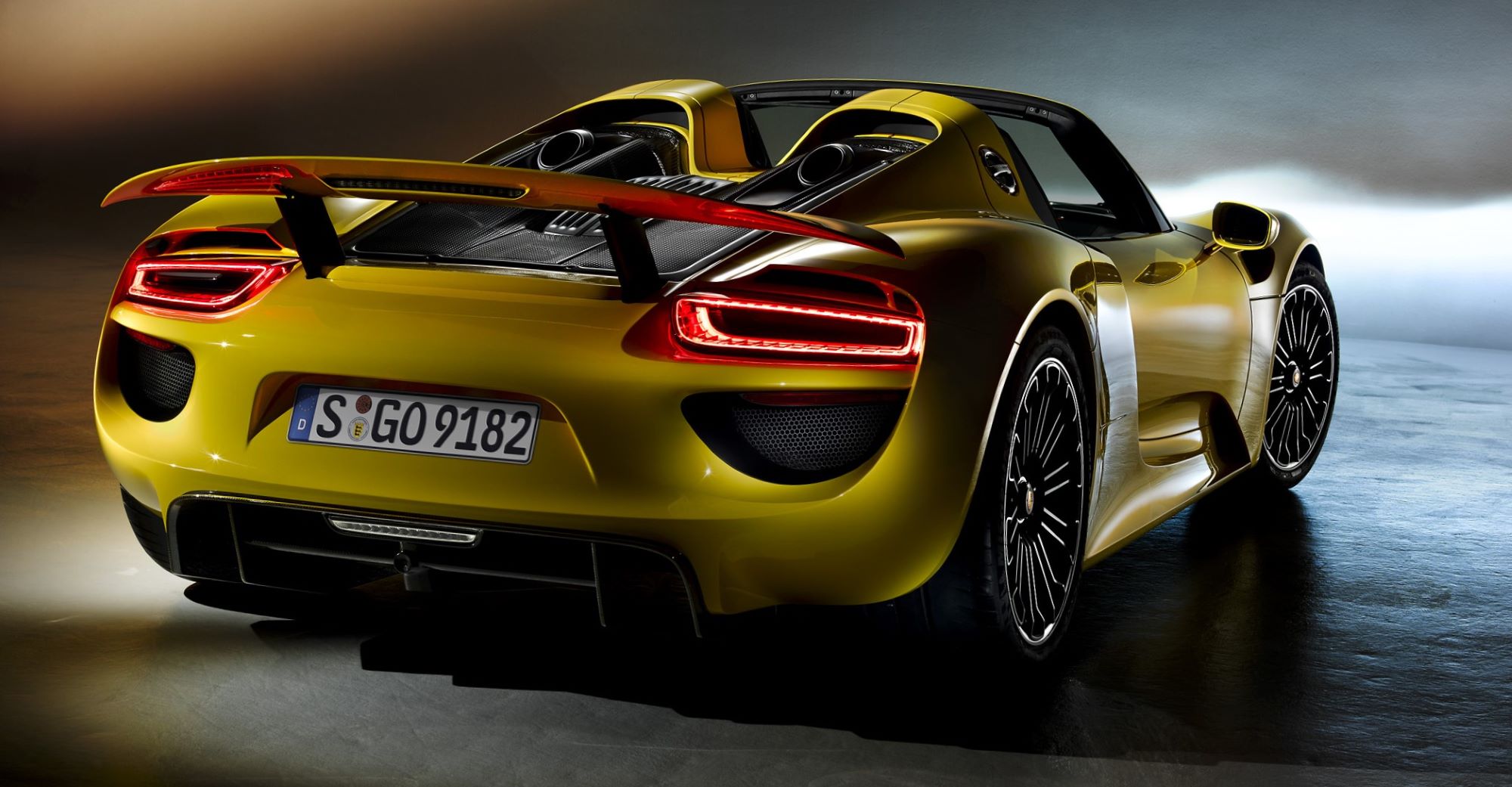
Extremely lightweight construction: CFRP body shell, thin windshield glass, plastic front and rear bumpers
As the body shell is separate from the supporting structure in terms of functions, it has been developed to optimal effect with low weight and best aerodynamics in mind. While the body shell and doors are made almost entirely of carbon-fibre-reinforced plastic, the front and rear bumpers are made from extremely light and flexible polyurethane (PU). Being made from this material enables them to withstand minor knocks without sustaining damage. The windscreen is made of extremely light, highly flexible thin glass, which offers effective protection against problems such as stone chips.
As the name Spyder suggests, the new Porsche 918 is designed as an open and particularly emotive roadster. Two roof panels are inserted between the windscreen frame and the roll-over protection system behind the headrests that form part of the monocoque’s supporting structure. These panels are also made entirely of CFRP and can be removed separately and stowed in the luggage compartment. To increase the comfort of open driving, particularly at higher speeds, a wind deflector can be attached to the windscreen frame. The wind deflector is stored in the luggage compartment when driving with the roof closed.
Like liquid metal: Nine top layers of paint
By providing two optional special colours for the exterior, Porsche is offering up a particularly exclusive visual experience. The paint structure and processing technique were developed specifically for the new super sportscar. The paint can be applied to carbon surfaces for the first time and gives the appearance of liquid metal. The new type of paint, which is of a particularly high quality, is applied with pinpoint precision in nine layers.
As part of this process, the paint structure is applied three times by hand. The subsequent top coat comprises two layers of clear varnish that create impressive light reflections, delivering an extraordinary depth effect. Each light reflection brings the contours and design lines of the 918 Spyder ever more clearly to the surface. The new paint is available in the special colours liquid metal silver and liquid metal chrome blue, and supplements the ten standard colours on offer.
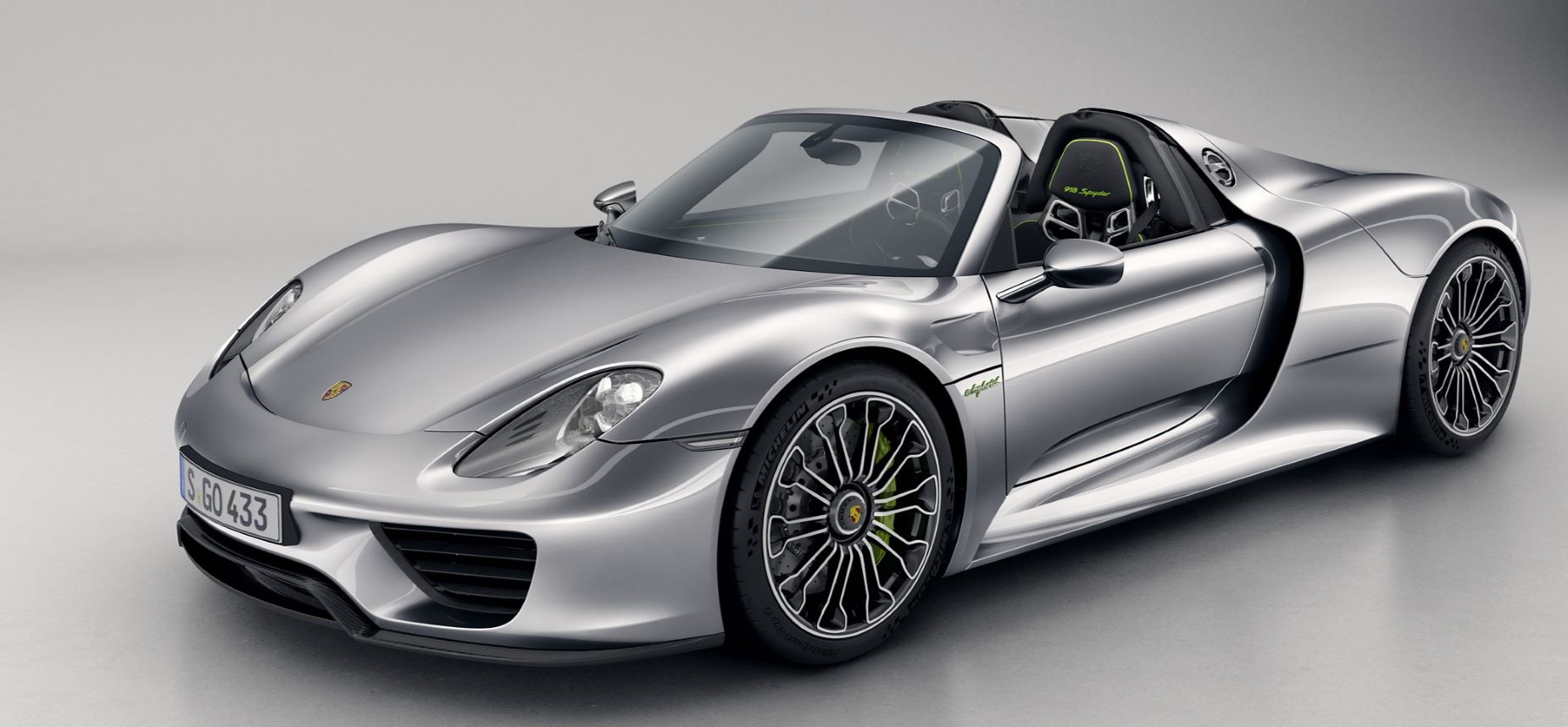
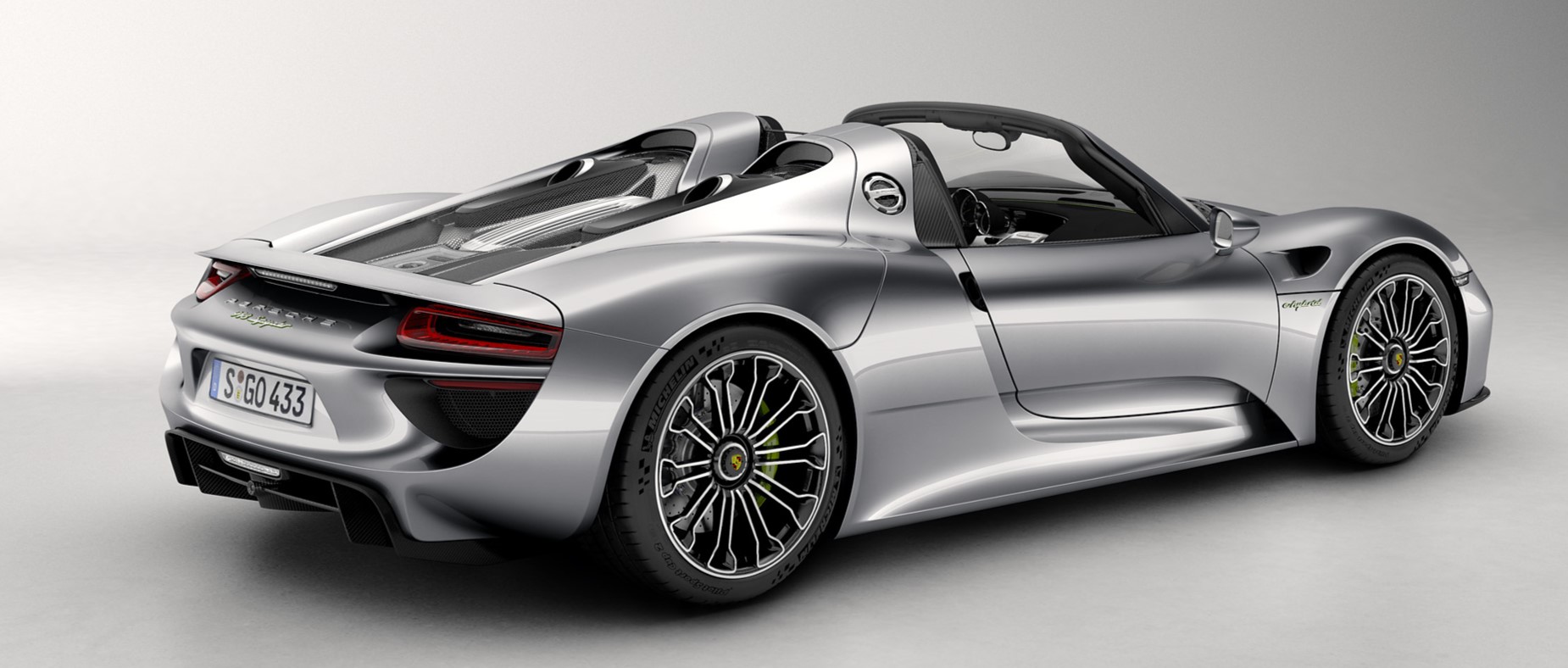
Operating strategies and driving modes
From comfortable to race-ready: Five modes for three motors
The centre piece of the 918 Spyder concept is the distribution of propulsive power across three power units, all of which are integrated and controlled via an intelligent management system. To benefit as much as possible from the coverage offered by the different systems, Porsche developers have defined a total of five operating modes. Just like in motorsport, these modes are activated via a map switch in the steering wheel.
Using the pre-selected mode, the 918 Spyder applies the most suitable operating and boost strategy, without the driver needing to do anything else. The selected operating strategy therefore influences not only how the three power units are used and how they interact, but also influences the shift programme of the PDK, the adaptive aerodynamics and the headlights. The leading expertise gained by Porsche in hybrid technology is instrumental in developing the maps and the algorithm stored in them for controlling the three power units and other systems.
Variable pressure point in the accelerator pedal
Each and every driver has intuitive feel to working out the behaviour and response of the 918 Spyder, and this takes the form of new haptic communication with the driver via the accelerator pedal. The 918 Spyder has a variable pressure point in the accelerator pedal that guarantees improved and more precise regulation of both the electric driving power in E-Power mode, and also the electric boost in the Hot Lap configuration. Unlike a conventional kickdown, the counterpressure in the 918 Spyder is retained after the pressure point has been exceeded.
An overview of the five modes and their strategies:
| E-Power | Hybrid | Sport Hybrid |
Race Hybrid |
Hot Lap |
|
| Drive strategy | electric | efficient | sporty | max. continuous power |
max. peak power |
| Electric drive | |||||
| Permanent | ● | ||||
| Alternative | ● | ||||
| Boost | ●● | ●● | ●●● | ||
| Combustion engine | |||||
| Permanent | ●● | ●●● | ●●● | ||
| Alternative | ● | ||||
| Boost | ● | ● | |||
| Variable pressure point in the accelerator pedal |
● | ● | |||
| Recuperation | ● | ● | ● | ● | ● |
| Charging via the combustion engine |
● | ●● | ●●● | ●●● | |
| Start-stop | ● | ● | |||
| Coasting | ● | ● | |||
| PDK shifting strategy | |||||
| low-speed, efficient |
● | ● | |||
| high-speed, fast |
●● | ●●● | ●●● | ||
| Adaptive aerodynamics | |||||
| Efficiency | ● | ● | ● | ||
| Speed | ● | ● | ● | ||
| Performance | ● | ● | |||
| Lights | Eco (18 W) | Eco | Eco | Race (25 W) | Race |
● active; ●● boosted; ●●● maximum
Depending on a range of parameters, such as the selected mode, speed and acceleration, the hybrid manager regulates the energy flows between the three power units and the traction battery. These flows are shown on the eight-inch information display for the centre console in the form of energy flow diagrams.
Quiet and dynamic: “E-Power” at speeds as high as 150 km/h
When the vehicle is started up, “E-Power” mode is selected as the default operating mode, provided that the battery has sufficient charge. In ideal conditions, the 918 Spyder can cover over 30 kilometres on purely electric power. Even in electric mode, the 918 Spyder accelerates from 0 to 100 km/h in slightly over seven seconds and can reach speeds of up to 150 km/h.
In E-Power mode, the variable pressure point of the accelerator pedal limits the vehicle’s electric driving capabilities. The combustion engine kicks in if the driver exceeds the kickdown threshold. This means that the driver can specifically prevent the combustion engine kicking in inadvertently. The driver also has the full performance of all three power units available at all times, such as during an overtaking manoeuvre. E-Power mode remains active in the background and the combustion engine is switched off again at lower speeds or during moderate acceleration. If the battery charging condition drops below a set minimum level, the vehicle automatically switches to “Hybrid” mode.
Efficient and convenient: “Hybrid” for more energy from every drop of fuel
In “Hybrid” mode, the electric motors and combustion engine work alternately, focusing on achieving maximum efficiency and minimum fuel consumption. The power output of the individual drive components is modified in line with the current driving situation and the required performance level. Hybrid mode is typically used for fuel-efficient driving. A central role in terms of the efficiency of the 918 Spyder is not only played by energy recovery by means of recuperation, but also by raising the load point. The rear electric motor acts as a generator to achieve this. The result is an increased load until the combustion engine operates in more efficient load ranges through dethrottling. As a result, the super sportscar draws more energy for traction out of every drop of fuel when charging via the combustion engine; this energy is then stored in the traction battery.
Sporty and dynamic: “Sport Hybrid” for performance at maximum speed
If a more dynamic performance is required, the power units in the 918 Spyder switch over to “Sport Hybrid” mode. The combustion engine now operates continuously, representing the main propulsive force. The electric motors step into the scene, either to provice electric boost function, or at points when the operating point of the combustion engine can be optimised for greater efficiency (load point reduction). This mode focuses on performance and a sporty driving experience at top speeds.
Even sportier and more dynamic: “Race Hybrid” for quick laps
“Race Hybrid” is the mode for maximum performance combined with an especially sporty driving experience. The combustion engine is chiefly used under high load. The electric motors also provide additional support in the form of boosting in this mode. The gearshift programme of the PDK is also designed for even sportier driving. In this mode, the battery charging condition is not kept constant and instead fluctuates over the entire charge range.
Electric power is thus always available to the driver even for several very fast laps. In contrast to Sport Hybrid mode, the electric motors are run at their maximum power output limit for a short period, thereby producing greater boost performance. This higher power delivery is balanced out with increased charging of the battery by the combustion engine if its full power is not used (raised load point). If the driver uses three-quarters of the power of the V8 while driving at high speeds on fast motorway, for instance, the system operates at full throttle and uses the last quarter to charge the battery. In this way, the electric motor generates around 200 ampere while operating as a generator, which would allow a flat battery to be fully charged in less than 20 minutes.
Maximum power: “Hot Lap” for taking pole position
The “Hot Lap” button in the centre of the map switch releases the 918 Spyder’s final reserves and can only be activated in “Race Hybrid” mode. Similar to a qualification mode, the traction battery is pushed to its maximum power output limits for a few fast laps. This mode uses all of the available energy in the battery. In this configuration, the variable pressure point in the accelerator pedal supports the driver as a tangible switching threshold for the electric boost. It can therefore accurately meter the additional power of the electric boost, such as for sensitive acceleration out of bends on the racetrack.
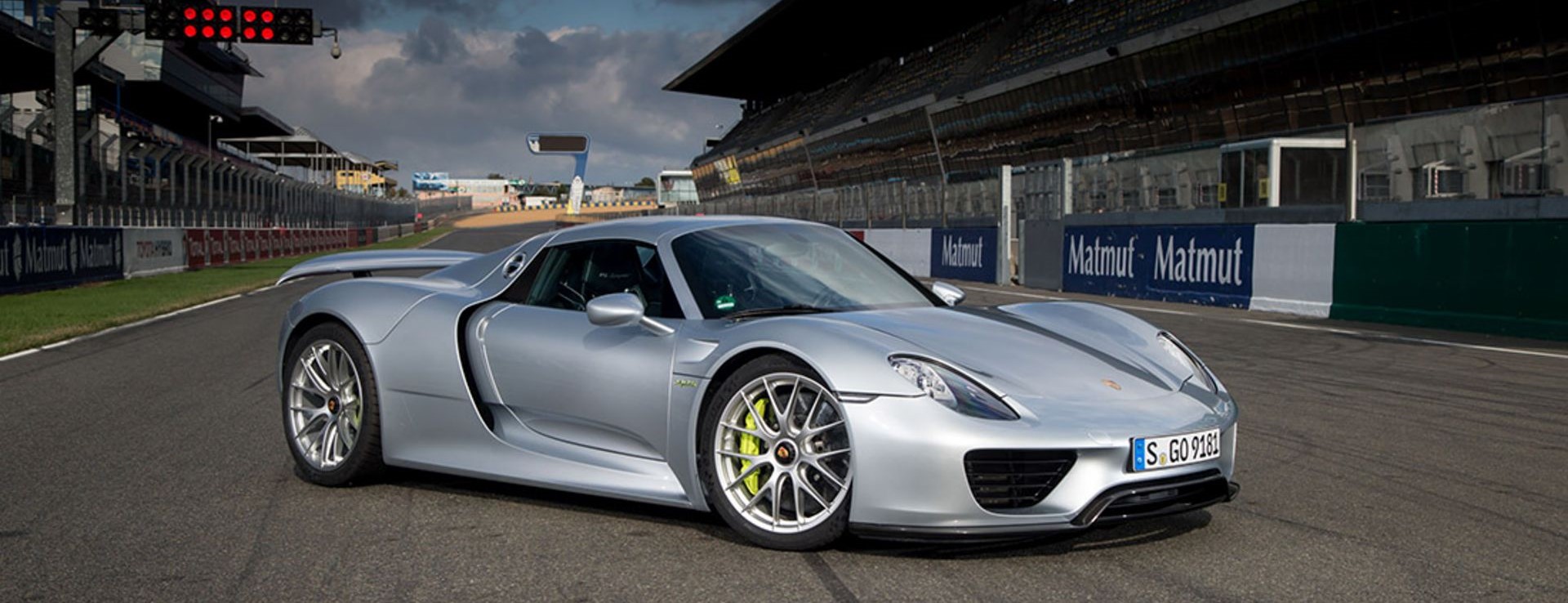
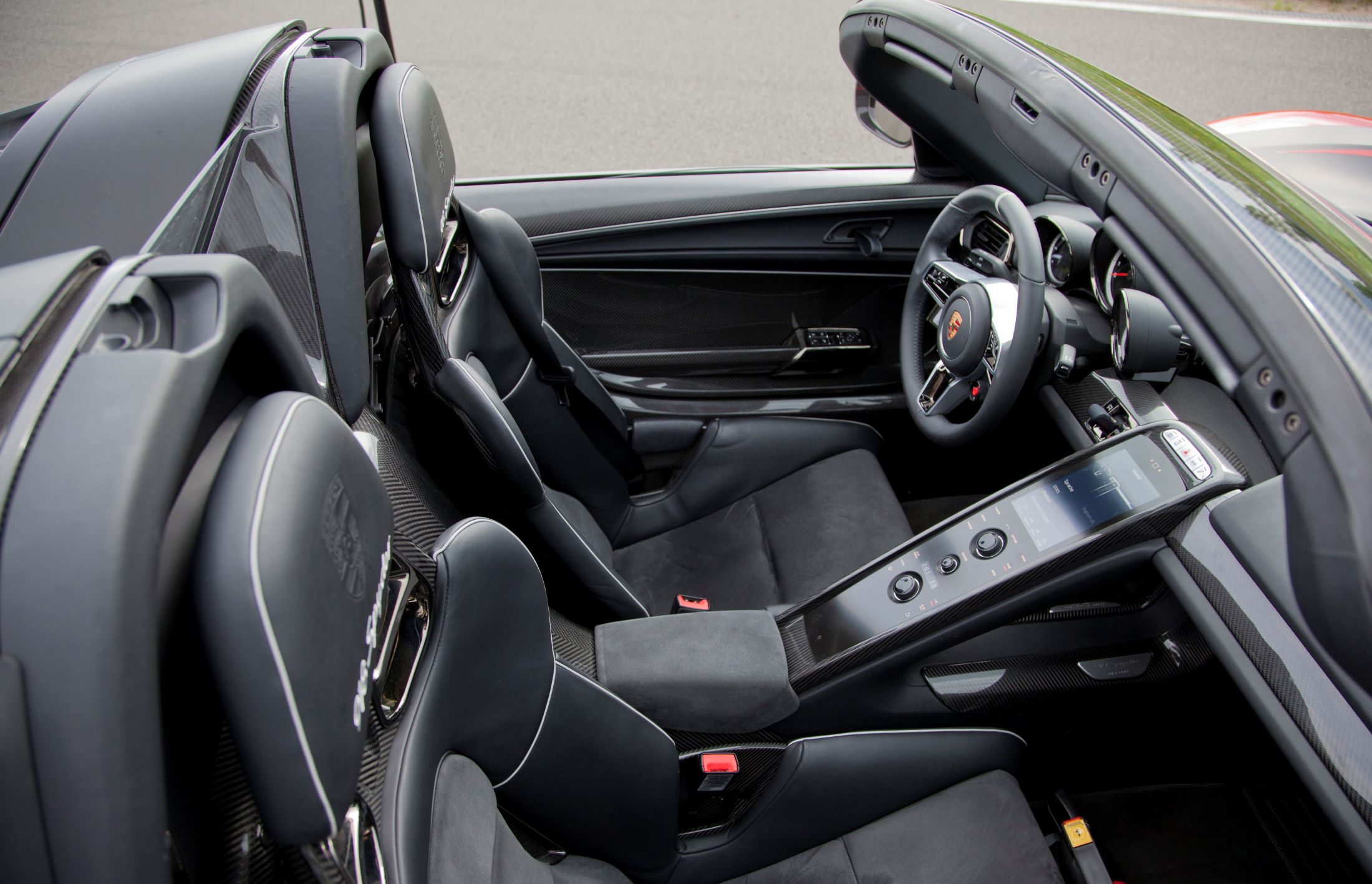
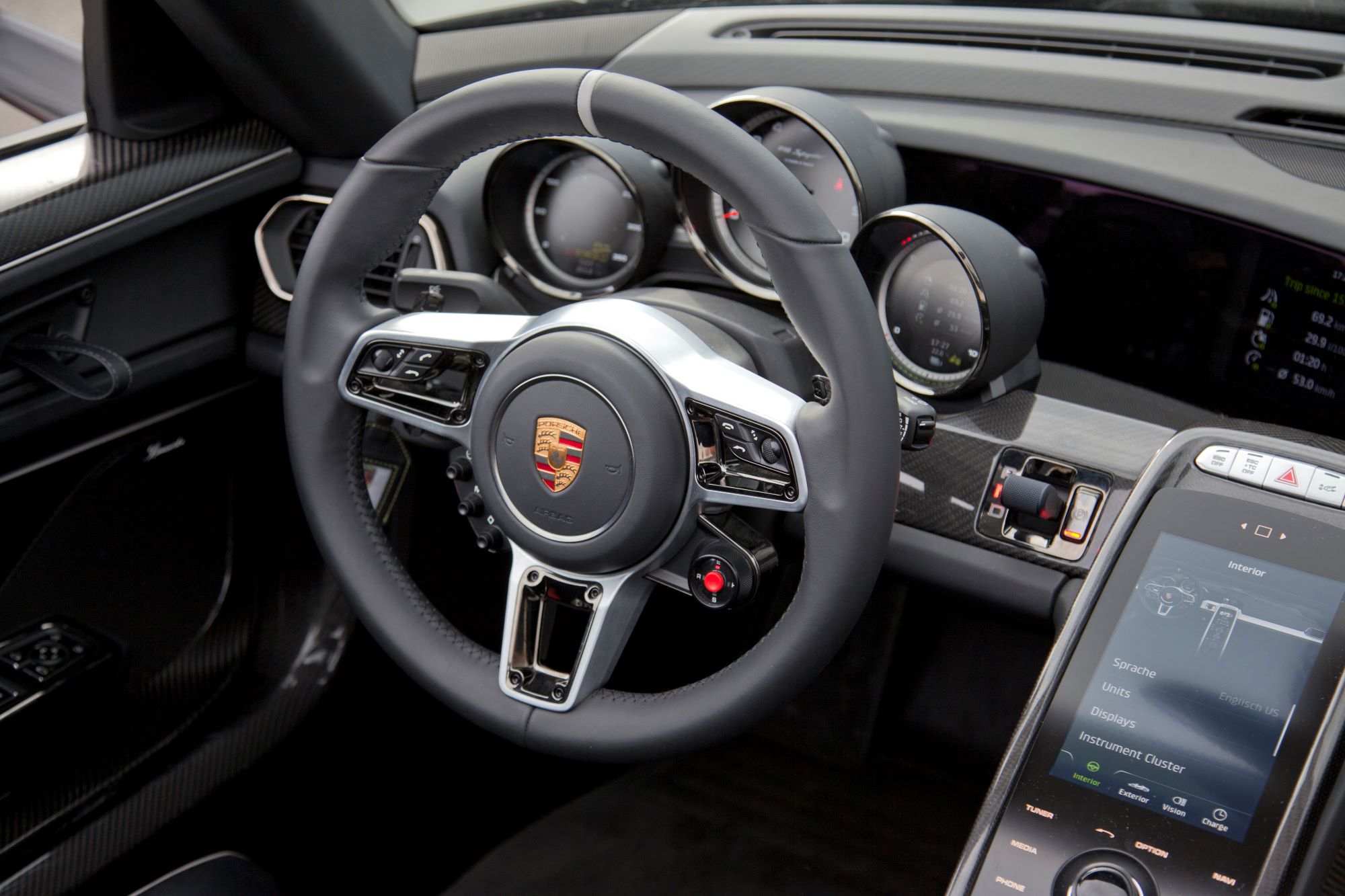
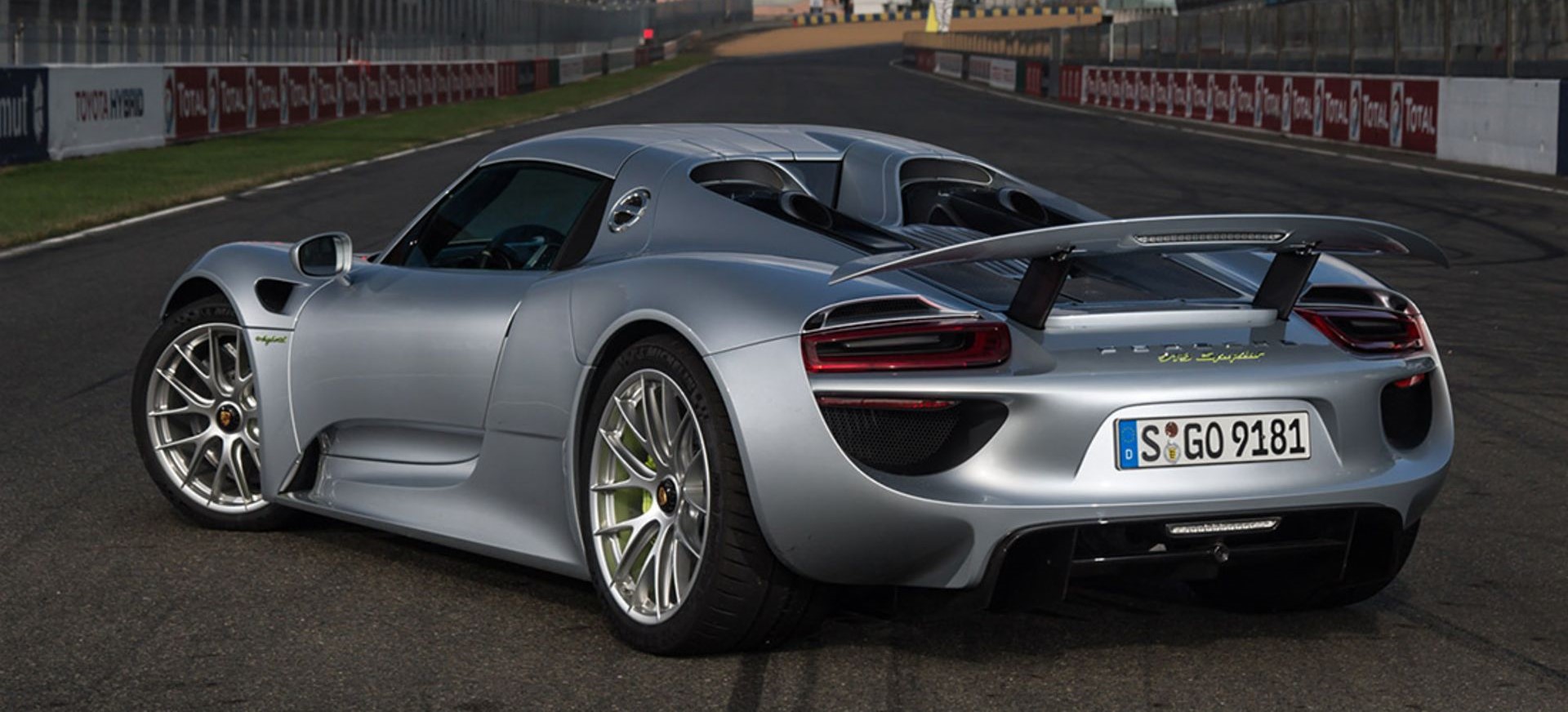
Engine and transmission
Outstanding performance courtesy of unique hybrid concept
The 918 Spyder is the first production vehicle to have three independent power units that can be controlled separately. The combustion engine and rear electric motor are arranged in series on a common axle and drive the rear axle via the PDK. The second electric motor acts on the front wheels via a single-stage gearbox and a decoupler.
The benefit is that electric drive units have properties additional to those of combustion engines – particularly in the case of sportscars. The drive units offer extremely high performance, maximum torque is available straight after coming to a stop, and they are far more efficient in broad speed ranges. Above all, however, energy that can be used again for acceleration (electric boost) can be regained using the electric motors (recuperation).
Electric motors and a V8 engine: 0 to 100 km/h in 2.6 seconds and 0 to 200 km/h in 7.3 seconds
Tuning the three drive sources so they are at their peak is one of Porsche’s core competencies and it ensures the 918 Spyder’s outstanding performance. Overall, the 918 Spyder achieves maximum system performance of 887 hp and a crankshaft-equivalent maximum torque of 1280 Nm in seventh gear. That’s around one-and-a-half times of a Cayenne S Diesel, which was previously the most powerful Porsche in terms of torque on account of the 850 Nm provided by its V8 biturbo engine.
The term “crankshaft-equivalent” in this context expresses the level of torque the engine would have to produce in the case of a conventional drive to build up and deliver the same tractive force to the drive wheels. The characteristics of the high-speed, naturally aspirated engine delivering significant torque at elevated rpm levels, and the electric motors delivering significant torque even from stationary, complement one another perfectly: Within a broad speed range of 800–5000 rpm, the torque level remains above 800 Nm at all times.
For the driver, this means virtually limitless power from the very first revolution, paired with fast starts, a powerful response and impressive acceleration. It also ensures enormous driving pleasure when the powerful-torque electric motors provide an additional boost to the V8 high-speed engine, delivering catapult-like accelerating power. The vehicle accelerates from 0 to 100 km/h in 2.6 seconds, and from 0 to 200 km/h in 7.3 seconds.
The key engine data at a glance:
| V8 | Electric motor, rear | Electric motor, front | ||
| Displacement | cm³ | 4593 | ||
| Nominal power | hp (kW) | 608 (447) | 156 (115) | 129 (95) |
| at (rpm) | 8700 | |||
| Nominal torque | Nm | 540 | 375 | 210 |
| at (rpm) | 6700 | 0–2000 | 0–3500 | |
| Maximum engine speed | rpm | 9150 | 9150 | 16,000 |
| Nominal voltage | V | 385 | 385 | |
| Specific power | hp/l (kW/l) | 132 (97) | ||
| Compression ratio | ε | 13.5:1 | ||
| Weight | kg | 135 | 30 |
Main drive: Eight-cylinder 4.6-litre naturally aspirated engine straight from the race car
Main drive source in the 918 Spyder is a tamed racing engine. At 132 hp/l, the supercar houses the highest specific power for a naturally aspirated engine in a Porsche; at 135 kilograms, the engine is also the lightest production V8 naturally aspirated engine. The eight-cylinder adopts the conventional bank angle of 90 degrees, but features a “flat plane” crankshaft taken from motorsport with crankshaft throws offset by 180 degrees for the connecting rods. From the acoustics alone, it is clear that the power train in the Spyder is a racing engine.
This crankshaft layout is tried and tested in motorsport and offers a number of benefits. The firing sequence enables the high specific power and the extremely high torque. At 13 kilograms, the shaft is very light, making the engine extremely free-revving and highly dynamic. The connecting rod bearings are oiled centrally via the hollow-bored crankshaft, as is the norm in motorsport.
The 4.6-litre engine is taken directly from the power unit of the successful RS Spyder. It delivers 608 hp (447 kW) at 8700 rpm, with a maximum engine speed of 9150 rpm. The Porsche engineers have developed a particularly efficient, low-emission combustion process in the form of direct injection with centrally arranged magnetic coil injectors. The injectors deliver the fuel to the combustion chambers at up to 200 bar across seven bores. Like the RS Spyder racing engine, the 918 Spyder power unit has dry sump lubrication with a separate oil tank and oil extraction to individual chambers.
To optimise the engine weight, components such as the oil tank, the air filter box integrated into the unit carrier and the air intake are all made from CFRP. Other comprehensive lightweight construction measures resulted in titanium connecting rods, thin-wall low-pressure casting on the crankcase and the cylinder heads, and in the extremely thin-walled manufactured exhaust system made from steel-nickel alloy. A striking feature of the V8 is the fact that it no longer supports any auxiliary systems – there are no exterior belt drives. As a result of this omission, the power unit is especially compact.
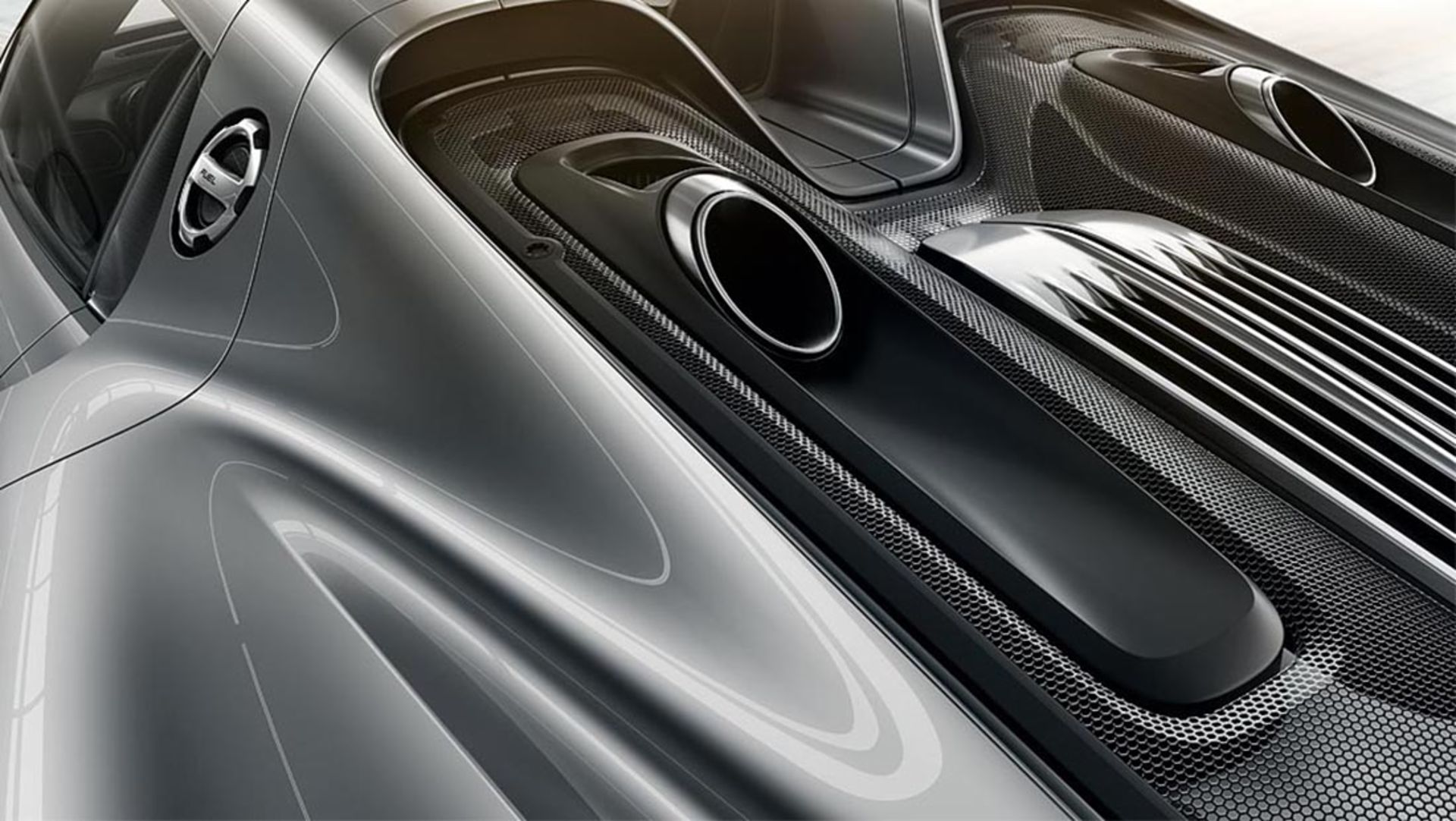
Unique roots in racing car manufacturing: Top pipes
The V8 engine adds an emotive charge to the 918 Spyder through both its performance and its sound. Apart from the firing sequence, this can be attributed primarily to the “top pipes” – the exhaust tailpipes that terminate directly above the engine in the upper part of the rear end. No other series production vehicle features this solution. The greatest technical benefit offered by the top pipes is optimal heat removal, as the hot exhaust gases are conveyed away over the shortest direct route and the exhaust back pressure remains low. The driver and front passenger experience similar interior acoustics to those of the RS Spyder. Until now, this has only been possible in this form in race cars on account of standardisation regulations.
The design calls for a new thermodynamic air duct concept: On the HSI motor, the hot side is inside the cylinder V, and the suction sides are on the outside. Another benefit is that the engine compartment remains cooler, which is due primarily to the lithium-ion traction battery. It delivers its best performance figures in a temperature range from 20 to 40 degrees Celsius. Working in this temperature range means it takes less energy to actively cool the battery.
Electric motor for the rear axle: Parallel in the drive train
The hybrid module connects to the V8 engine. Like Porsche’s current hybrid models, the 918 Spyder is constructed as a parallel hybrid. The hybrid module essentially comprises a 115-kW electric motor and a dry decoupler that serves as the connection element to the combustion engine.
Because of its parallel hybrid configuration, the 918 Spyder can be powered at the rear axle either individually by the combustion engine or the electric motor, or via both drives together. As is typical for a Porsche super sportscar, the internal combustion engine assembly in the 918 Spyder has been positioned in front of the rear axle, and does not have a direct mechanical connection to the front axle.
Hybrid cooling for the hybrid module
Porsche has developed a new cooling strategy for the permanently energised synchronous motor with an external armature and single-tooth winding: It is the first hybrid motor to be cooled with both water and air. The electric motor has a third more power and torque than that of the motor in the Panamera S E-Hybrid, which means that there is a greater need to dissipate heat. To combat this, Porsche engineers developed a new cooling strategy, in which the stator – i.e. the stationary inner part of the electric motor – is still water-cooled as before. However, the permanent magnets of the outer rotating part are air-cooled.
This is accomplished by a blower wheel that draws in outside air via the air filter by means of an air channel with flow distributor. The heat is dissipated via a large number of ducts integrated into the housing. This solution guarantees uniform flow distribution and even cooling of the coils. This extremely efficient cooling system is a basic prerequisite for a high level of continuous power, such as on the race track.
Headfirst for low centre of gravity: Porsche Doppelkupplung
A seven-speed Porsche Doppelkupplung (PDK) handles power transmission to the rear axle. The high-performance transmission is the sportiest feature of the successful PDK and has undergone a complete facelift for the 918 Spyder and optimised further for performance use. In comparison with other Porsche model lines, the transmission has been rotated around the longitudinal axis by 180 degrees onto its head to guarantee the deepest possible installation position and thus the lowest possible centre of gravity for the entire vehicle. If driving power is not required at the rear axle, the two drives can be uncoupled by opening the decoupler and PDK clutches. The “coasting” function with the combustion engine switched off, which is typical for a Porsche, is therefore possible up to a speed of 150 km/h.
Electric motor for the front axle: Independent all-wheel drive
The second electric drive of the 918 Spyder has a mechanical effect on the front axle, independently of the rear wheels. The drive torque is controlled separately for each axle, which is why the hybrid super sportscar features electrical Porsche Traction Management (ePTM). This system affords the 918 Spyder its unique traction and driving dynamics. Unlike the rear axle, the electric motor is a permanently energised synchronous motor with an internal armature. This type of electric motor concentrates a particularly large amount of power on small volume with high torque and low weight.
The downstream transmission is designed for the best possible performance both in terms of starting up and when taking to the race track. To this end, the constant gear ratio is selected such that high torque is created at low speeds. The electric motor reaches its maximum revolutions at 16,000 rpm, which corresponds to a speed of around 265 km/h. At speeds above this, the transmission and the electric motor are decoupled via the integrated jaw clutch. The electric all-wheel drive function is therefore available virtually at all times.
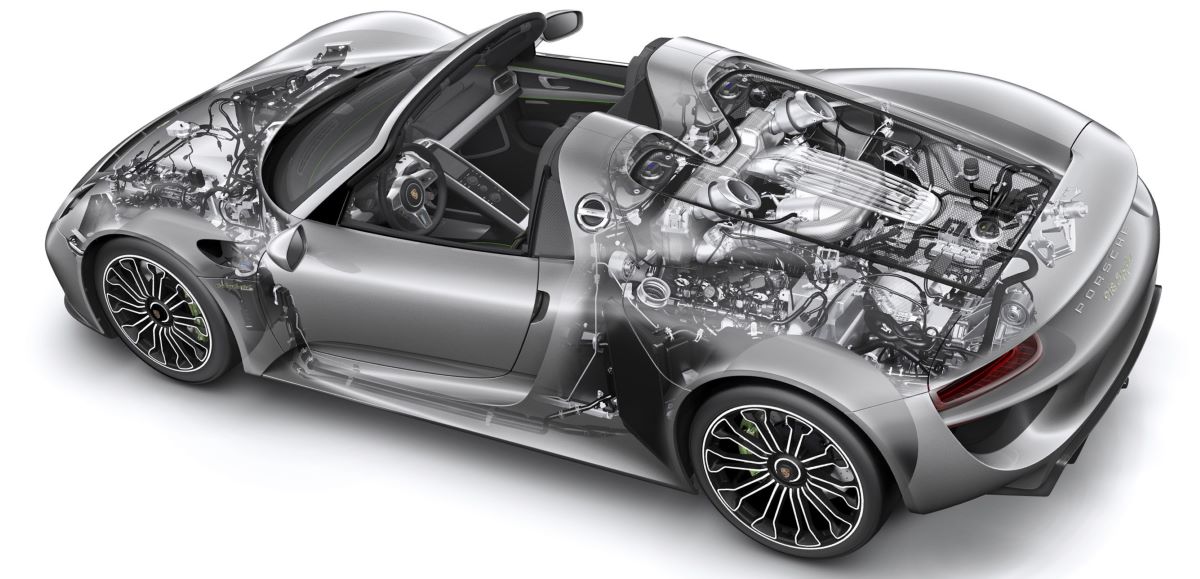
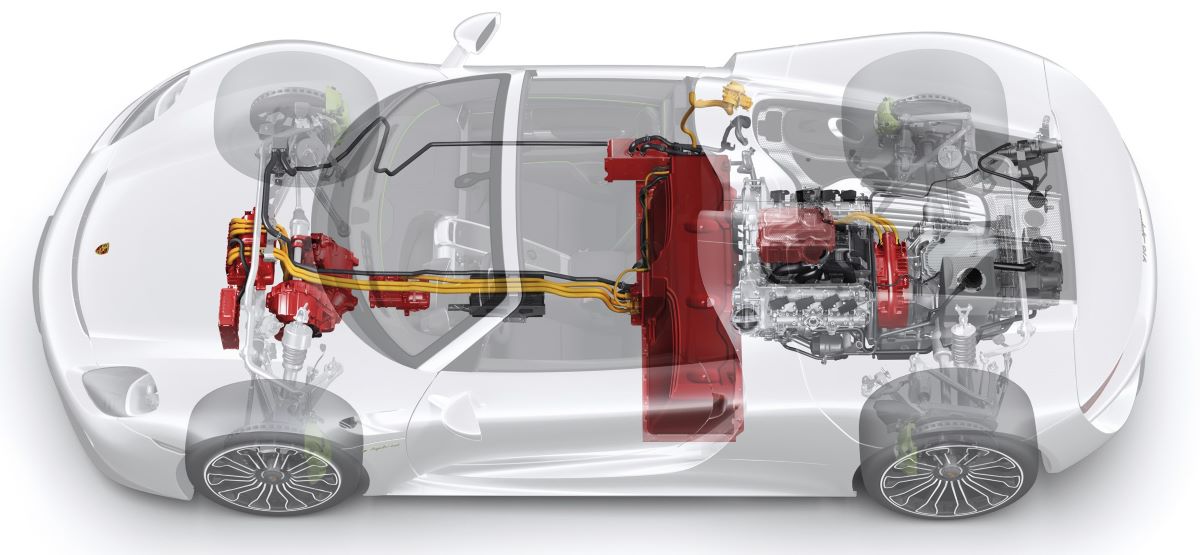
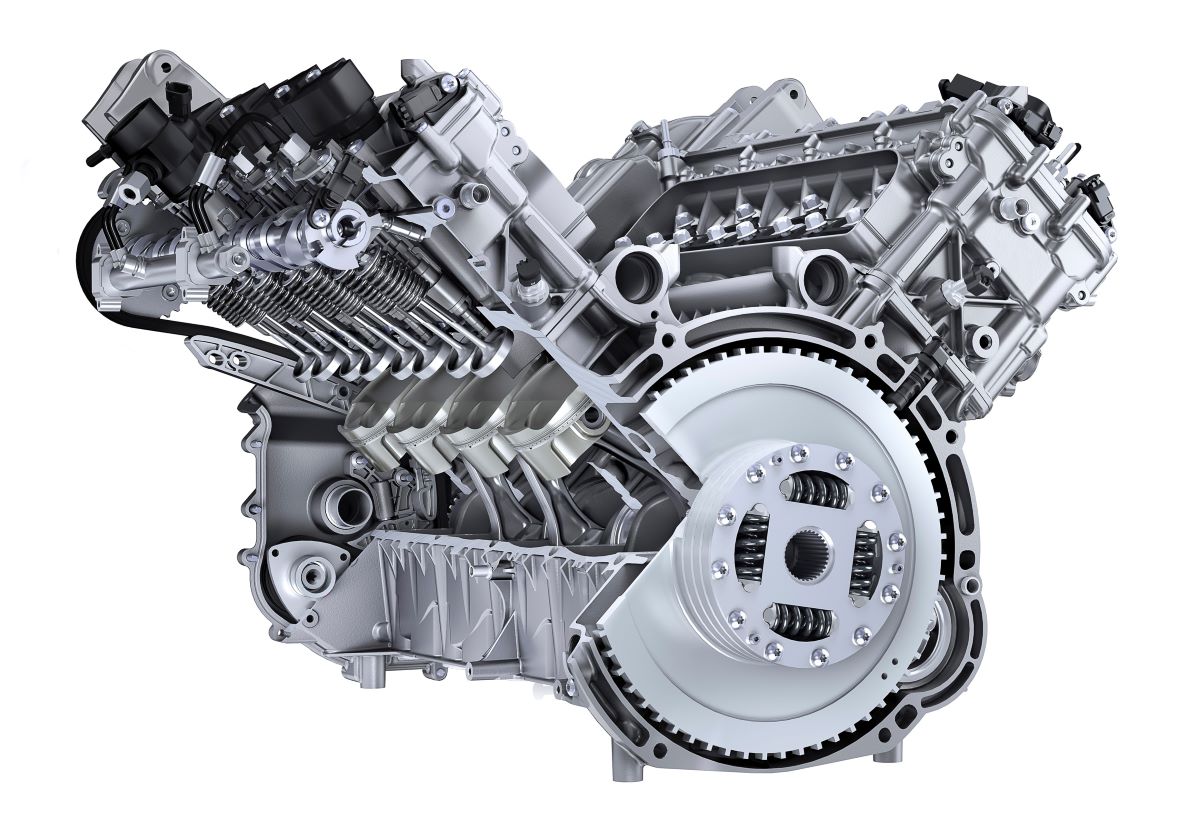

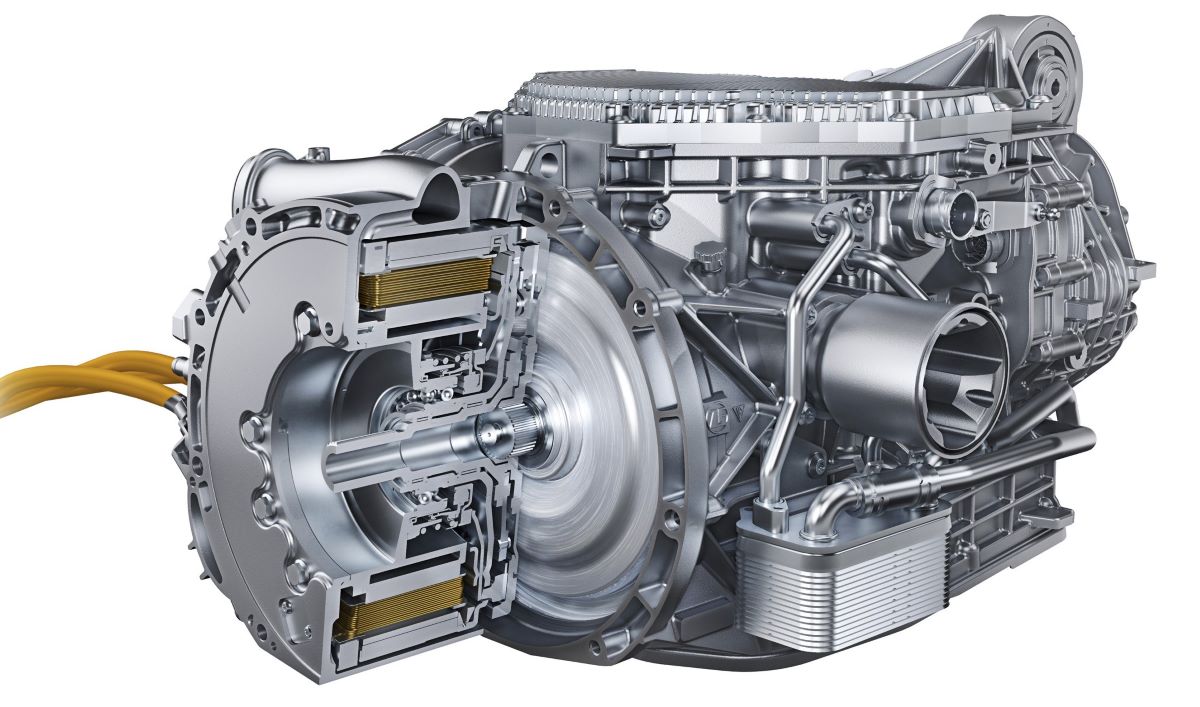

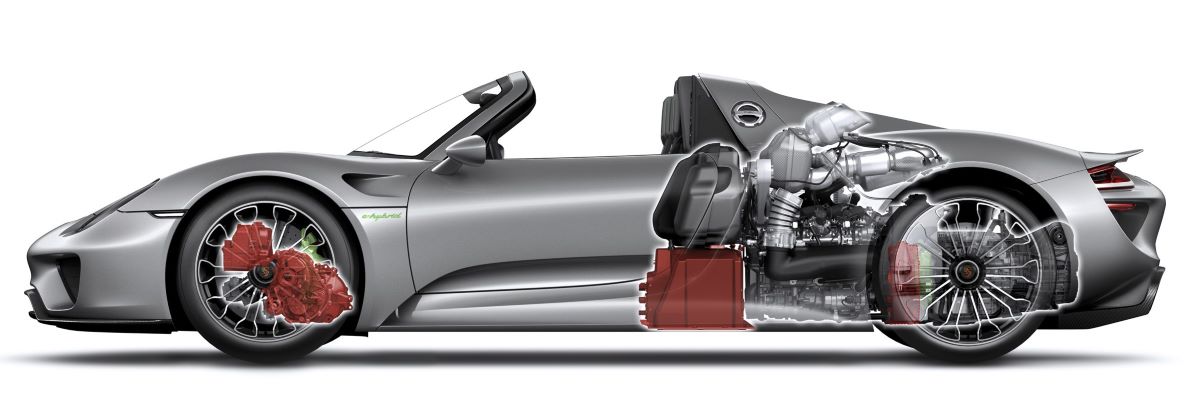
Chassis, tyres and brakes
Chassis with race car genes and rear-axle steering
The outstanding driving dynamics of the 918 Spyder is the result of pure racing technology. Design, construction and components of the chassis and running gear come directly from the RS Spyder. The front wheels are driven by a double control arm axle, and the rear wheels by a multi-link axle. The properties of this racing chassis are further refined by the active shock-absorber system (PASM) and the rear-axle steering.
Active safety is ensured by Porsche Stability Management (PSM) with a sport configuration that can be completely deactivated in two stages (ESC OFF and ESC+TC OFF). In addition, Porsche Torque Vectoring Plus (PTV Plus), with an electronically regulated rear-axle differential lock, enhances the traction in particular with a dynamic driving style.
All elements of the chassis are designed strictly according to the principle of minimum weight and maximum rigidity. The control arms of the chassis, which are all straight, are made from forged aluminium. The chassis mounts are metal “unibal” joints which, by dispensing with damping elastomers, ensure high-precision wheel location. The power transmission joints are known as tripod joints. They consist of a cylindrical housing with three integrated contact surfaces. The needle-mounted transfer rollers on the radial end of the drive shaft can move in these contact surfaces. As a result, the wheel hub and axle shaft move both axially and at an angle to one another during damper compression. Tripod joints are far more compact, lighter, and experience less friction than conventional constructions. Moreover, they guarantee even more direct feedback.
The wheel hub mounting in the wheel trunks also reflects pure racing technology thanks to the use of thin-ring wheel bearings. These bearings have a greater diameter than conventional ball bearings, have particularly thin inner and outer rings and are therefore lightweight in their construction. The thin-ring wheel bearings obtain the stability they require from an increased number of ball bearings and a particularly rigid connection to the wheel hubs and trunks. The combination of tripod joints and thin-ring wheel bearings saves around ten kilograms of weight compared with conventional bearing systems – 80 per cent of which is accounted for by unsprung weight.
Active rear-axle steering helps achieve quick lap times at the Nürburgring
The agility, stability, driving safety and, above all, racing car-like lateral dynamics of the 918 Spyder are in large measure thanks to the rear-axle steering – without which the record on the Nordschleife at the Nürburgring would not have been possible. The active rear-axle steering design consists of two electromechanical actuators, which are used on the left and right of the rear axle instead of the conventional tie rods. The steering angle of the rear wheels can be changed by up to three degrees in both directions.
This arrangement can be used to achieve one of two different effects, depending on which direction the two axles are turned. For instance, when the front and rear wheels are steered in opposite directions, the super sportscar drives like a model with a wheelbase 25 centimetres shorter. Exhibiting the corresponding manoeuvrability, the sportscar is particularly dynamic during steering and is more agile in bends.
The system controls this functionality at speeds below 50 km/h, which also makes manoeuvring and parking noticeably easier in everyday driving. The other effect is achieved when the front and rear wheels are steered in the same direction: The perceived wheelbase of the sportscar is lengthened by 50 centimetres, giving the driver better stability when changing lanes and therefore providing enhanced driving stability overall, especially at high speeds. What’s more, the build-up of lateral forces at the rear axle initiated in response to the driver’s steering input occurs much quicker than with an unsteered rear axle. This quicker build-up leads to a more spontaneous and harmonious initiation of changes in direction. Both axles are steered in the same direction when the vehicle reaches a speed of 80 km/h.
Hybrid brake system allows for extremely high levels of recuperation
The Porsche 918 Spyder can convert far more movement energy to electrical energy than other hybrid vehicles. The braking torque of the electric motors acting as generators is so great that they decelerate the super sportscar by up to 0.5 g. At a speed of 100 km/h, this equates to a stopping distance of 52 metres. A good twelve years ago this was still the prevalent braking performance of a medium-sized saloon car. As part of the braking process, the power units produce up to 230 kilowatts of power, which flows directly to the traction battery.
The new hybrid brake system in the 918 Spyder blends this tremendous recuperation performance with the reliable deceleration offered by a ceramic brake system fit for racing conditions. This is achieved via an electro-mechanical brake booster and an active volume accumulator, both of which are controlled by the recuperation management system. When the driver depresses the brake pedal, the vehicle initially decelerates; deceleration is controlled by the electric motors as far as possible.
To achieve deceleration, the active volume accumulator draws fluid from the brake hydraulics; as a result, the pressure exerted on the brake pads reduces until the rate at which the vehicle decelerates reflects the force applied to the pedal by the driver. The volume accumulator and brake booster only build the hydraulic brake pressure back up to meet the required level of deceleration when the full recuperation potential has been utilised. The result is consistent, even braking behaviour with the responsiveness and pedal feel typical of Porsche vehicles. The 918 Spyder employs the particularly light and powerful Porsche Ceramic Composite Brake (PCCB) system as a hydraulic brake system.
Just like a race car: Wheels and tyres in different sizes
The 918 Spyder features 20-inch wheels on the front axle and 21-inch wheels on the rear. These different wheel sizes fulfil the axle-specific requirements in a particular way: The 20-inch wheels on the front axle support agility and steerability, while the 21-inch wheels on the rear axle support traction. Moreover, the different wheel sizes underline the dynamic form of the 918 Spyder. All wheels feature a newly developed central locking mechanism derived from Porsche motorsport vehicles.
Special sports tyres (UHP = Ultra High Performance) bearing the name Pilot Sport Cup 2 have been developed by Michelin for the 918 Spyder. On a dry road surface in particular, these tyres offer a very high level of performance potential with high traction, lateral acceleration and short stopping distances, without compromising the properties on wet surfaces. They also have low rolling resistance to bring about improved efficiency.
Optional lift system for superb everyday suitability
In the manner typical of a race car, the ground clearance of the 918 Spyder has been optimally designed with aerodynamics in mind, which is why Porsche offers an electro-pneumatic lift system for the front axle as an option. This lift system raises the body at the front by around 30 mm and makes it easier to access underground car parks, for example. The system is activated via an operating button located in the centre console. The raising action takes two to three seconds to complete and can be performed at speeds of up to around 50 km/h.
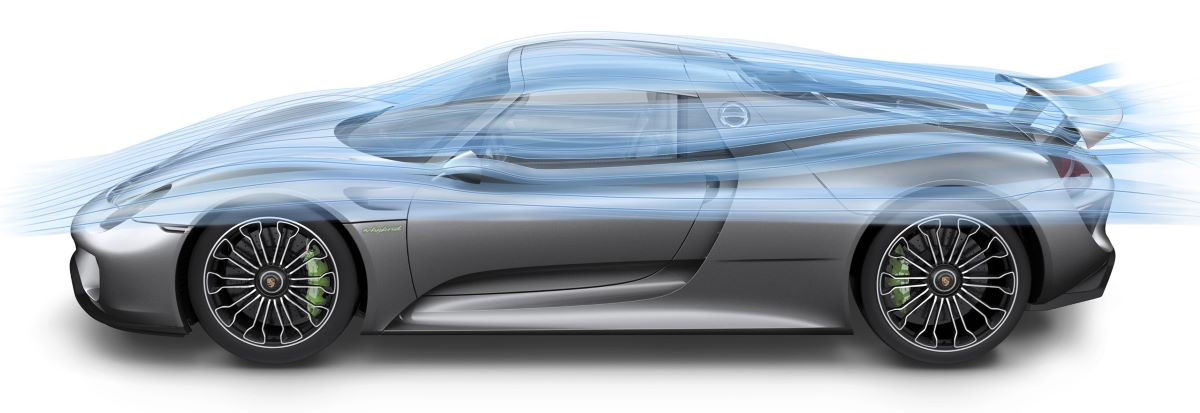
Adaptive Aerodynamics
Porsche Active Aerodynamic (PAA) coordinated with driving modes
When designing the 918 Spyder body shell, it was possible to focus on achieving optimum aerodynamic properties, in addition to the design itself, thanks to the rolling chassis construction. All air intakes and outlets are integrated aerodynamically into the body to optimal effect. These are designed to conduct air flows through and around the vehicle in an optimum manner. Another aerodynamic and highly effective area is the fully closed underbody, which provides an undisturbed and even air flow underneath the vehicle.
Porsche Active Aerodynamics (PAA) is a system made up of adjustable aerodynamic elements that provides a unique and variable aerodynamic response. The system works in three stages, switching automatically between optimum efficiency and maximum downforce, and working in harmony with the hybrid drive operating modes. In “Performance” mode, the retractable rear wing is set to a steep angle to generate high downforce at the rear axle. The spoiler, which is positioned between the two wing supports at the trailing edge of the airflow, also extends. Two adjustable air flaps are opened in the underbody in front of the front axle, directing some of the air into the diffuser channels of the underbody structure to also produce a “ground effect” at the front axle.
In “Speed” mode, the aerodynamics control system reduces the approach angle of the rear wing slightly, enabling a higher top speed. The spoiler remains extended and the aerodynamic flaps in the underbody close, ensuring there is no change in aerodynamic balance. In “Start” mode, the control system focuses solely on low aerodynamic drag; the rear wing and spoiler are retracted and the underbody flaps are closed.
| “Start” | “Speed” | “Performance” | |
| Extended height of rear wing | 0 mm | 120 mm | 120 mm |
| tilt angle | 2° | 8° | 14° |
| Rear spoiler | retracted | extended | extended |
| Front flaps | closed | closed | open |
Adjustable air intakes under the main headlights round off the adaptive aerodynamics system. These intakes are controlled via the driving modes. When the vehicle is stationary and in “Race Hybrid” or “Sport Hybrid” mode, the intakes are opened to enable maximum cooling. In “E-Power” and “Hybrid” mode, the air intakes close as soon as the vehicle is driven off in order to keep aerodynamic drag to a minimum. They are not opened again until the vehicle reaches speeds of approximately 130 km/h or when cooling requirements are higher.

Technical Specifications – Porsche 918 Spyder
| Body: | Two-seat Spyder; carbon fiber reinforced plastics (CFRP) monocoque interlocked with CFRP unit carrier; two-piece Targa roof; fixed roll-over protection system. |
| Drivetrain: | Parallel full hybrid; 4.6-liter V8 mid-engine with dry-sump lubrication; hybrid module with electric motor and decoupler; electric motor with decoupler and gear unit on front axle; auto start/stop function; electrical system recuperation; four cooling circuits for motors, transmission and battery; thermal management. |
| Engine power: | 608 hp at 8,600/min (V8 engine) 154 hp (hybrid module on rear axle) 127 hp (electric motor on front axle) 887 hp (combined) |
| Max. torque: | 390 lb.-ft. at 6,600/min (V8 engine) 940 lb.-ft. (equivalent torque calculated on the crankshaft, complete system in 7th gear) 787 lb.-ft. (complete system, 3rd gear) > 590 lb.-ft. (800/min – 5,000/min) |
| Maximum Revs: | 9,150 rpm |
| Power output per l: | 133 hp/l (V8 engine) |
| Power transmission: | Combustion engine with hybrid module and transmission bolted together to form a single drive unit; seven-speed Doppelkupplungsgetriebe (PDK); rear-wheel drive; front electric motor with gearbox for driving the front wheels (decoupled from 146 mph); five pre-selectable operating modes for optimum coordination of all drive units.
Gear ratios PDK |
| Chassis and Suspension: | Double-wishbone front axle; optional electro-pneumatic lift system on front axle; electro-mechanical power steering; multilink rear axle with adaptive electro-mechanical system for individual rear wheel steering; electronically controlled twin-tube gas-pressure dampers in the front and rear with Porsche Active Suspension Management (PASM). |
| Brake system: | High-performance hybrid brake system with adaptive recuperation; internally ventilated and perforated front ceramic brake discs (PCCB), 16 in. in diameter and 1.4 in. thick; rear discs 15.4 in diameter and 1.3 in. thick. |
| Wheels and tires: | 918 Spyder wheels (Weissach package: 918 Spyder magnesium wheels) front 9.5 J x 20 with 265/35 ZR 20 rear 12.5 J x 21 with 325/30 ZR 21 |
| Weights: | Curb weight 3,715 lbs. 3,616 lbs. (Weissach package) |
| Dimensions: | Length 182.8 in. Width 76.4 in. Height 45.9 in. Wheelbase 107.5 in.Track widthfront 65.5 in. rear 63.5 in.Luggage compartment capacity, VDA ~ 110 l Fuel tank capacity 18.5 gal |
| Energy supply: | Lithium-ion battery with 6.8 kWh capacity (BOL nominal), 220 kW maximum power and mains-compatible plug-in charger. |
| Performance: | Top speed > 211 mph purely electric 93 mphAcceleration: 0-62 mph 2.8 s 0-60 mph less than 2.8 s 0-62 mph (in electric mode) 7.0 s0-124 mph (0-200 km/h) 7.9 s0-186 mph (0-300 km/h) 23.0 s |
| Range: | Purely electric approx. 18 mi. |
| Warranty: | Vehicle (Battery) 4 years (7 years) |
| Charging times: | AC charging on a household socket (110 V, 10 A): less than 7 hours AC charging on an industrial socket (240 V, 30 A): less than 2 hours DC charging on an industrial socket (400 V, 32 A): less than 0.5 hours. |
